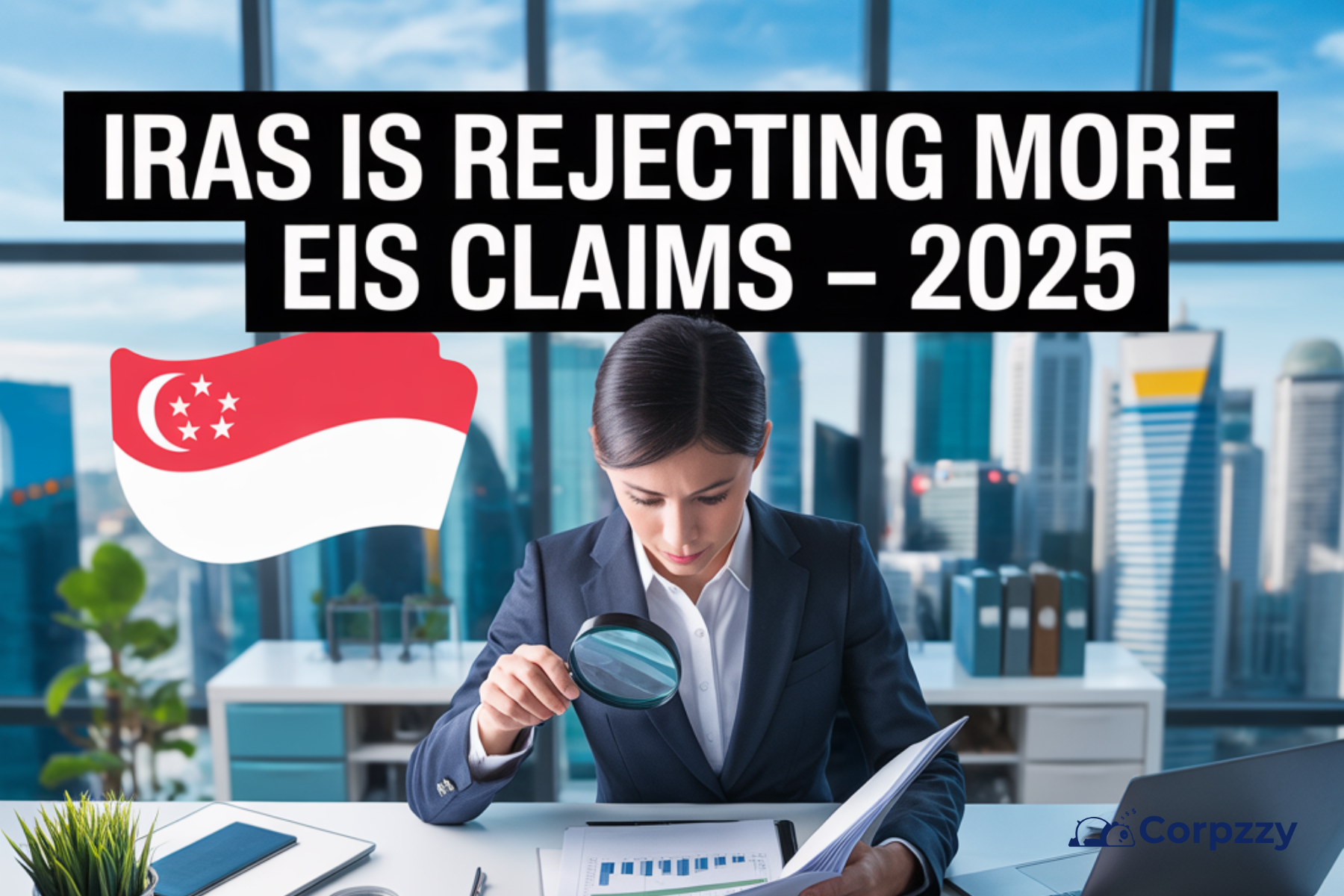Share Capital Reduction in Singapore: A Comprehensive Guide
Share Capital Reduction in Singapore: A Comprehensive Guide
Outline
- Key Takeaways
- What is Share Capital?
- Types of Shares in Singapore
- Why Consider Share Capital Reduction?
- Common Methods of Share Capital Reduction
- Legal and Filing Requirements
- Impact on Shareholders
- Role of Creditors in Share Capital Reduction
- Strategic Reasons to Reduce Share Capital
- Benefits of Share Capital Reduction
- Tax Implications and Considerations
- Share Buybacks and Capital Reduction
- Compliance with the Companies Act
- Professional Assistance and Advisory
- Summary of Key Steps
- Final Thoughts
- Questions? We Have Answers

Reducing share capital is a common financial strategy used by companies in Singapore to optimize their capital structure and maintain long-term financial health. While it may sound technical, the process is deeply rooted in practical business needs, regulatory compliance, and strategic planning. This guide is tailored for business owners, corporate secretaries, and investors looking to understand share capital reduction within the Singapore business context. Whether you operate in Singapore or plan to incorporate here, this article outlines everything you need to know.
Key Takeaways
- Share capital reduction in Singapore is a strategic tool to optimize a company’s capital structure.
- Companies can choose between court-approved or non-court-approved methods, depending on legal needs and creditor situations.
- The process must comply with the Companies Act and be properly filed with ACRA to be valid.
- Benefits include creating distributable reserves, enhancing financial flexibility, and supporting long-term profitability.
- Professional guidance is recommended to ensure compliance, manage risks, and align reductions with broader corporate goals.
What is Share Capital?
Share capital refers to the total amount of money that shareholders invest in a company in exchange for ownership shares. It represents the financial base upon which a company operates. This capital can be raised by issuing various types of shares, such as ordinary or preference shares. Understanding your company’s share capital is essential before considering any form of reduction.
In Singapore, there is no minimum share capital required to start a private limited company. However, most companies begin with a nominal amount such as SGD 1. Over time, this capital can be increased or reduced based on the needs and structure of the business. Share capital reduction comes into play when a company finds that its capital is excessive or inefficiently used.
Types of Shares in Singapore
Singapore companies typically issue two main types of shares: ordinary shares and preference shares. Ordinary shares carry voting rights and entitle shareholders to variable dividends. They are the most common type of shares held by business owners.
Preference shares, on the other hand, offer fixed dividends and have priority over ordinary shares in terms of dividend payments. These shares may also be redeemable, meaning the company can buy them back under certain conditions. Terms related to preference shares must be clearly stated in the company’s Constitution. Both share types may be subject to restrictions on transfer as outlined in the Articles of Association.
Why Consider Share Capital Reduction?
There are multiple strategic reasons why a company may consider reducing its share capital. First, excessive share capital can dilute shareholder value, especially if the capital is not being effectively utilized. Second, it may limit the company’s ability to distribute dividends, particularly if there are insufficient distributable profits.
Third, a leaner capital structure often supports higher return on equity (ROE), which is attractive to investors. Finally, companies may reduce share capital to return surplus funds to shareholders or prepare for share buybacks. It is essential to match the reason for reduction with the company’s long-term goals.
Common Methods of Share Capital Reduction
Share capital reduction can be executed through two main methods: court-approved or non-court-approved. Both methods require passing a special resolution by the company’s shareholders. The main difference lies in whether the process is overseen by the Singapore court.
Court-approved reductions offer more legal protection, especially in the case of creditor objections. Non-court-approved reductions, while faster and less costly, require a solvency statement from directors. The chosen method depends on the company’s risk appetite, financial condition, and regulatory comfort level.
The Court-Approved Method
Under this method, the company must first pass a special resolution for share capital reduction. Next, a notice must be submitted to ACRA informing them of the resolution. The company then seeks court confirmation, which involves proving that creditors are either consenting or adequately protected.
A qualifying creditor is one whose debt would be admissible in a liquidation scenario. Upon court approval, the company submits the court order via BizFile+ within 90 days. Once ACRA records the change, the reduction becomes legally effective. This method is favored by companies seeking definitive legal backing.
The Non-Court Approved Method
This streamlined process also begins with a special resolution by shareholders. However, it bypasses the court by requiring a solvency statement signed by all directors. This statement affirms that the company can pay its debts as they become due over the next 12 months.
The company must also submit several documents to ACRA within eight weeks of passing the resolution. These include the resolution, solvency statement, director’s declaration, and a notice of capital reduction. Once ACRA records the reduction, the new share capital structure takes effect.
Legal and Filing Requirements
In both methods, adherence to filing deadlines is crucial. Failure to submit required documents to ACRA within the stipulated timeframe may invalidate the entire process. Companies must also update their share register and notify shareholders accordingly.
Transparency and documentation are key to compliance. Companies are encouraged to consult a corporate secretary or legal advisor to ensure all steps are accurately followed. The effectiveness of the capital reduction depends on fulfilling both statutory and procedural requirements.
Impact on Shareholders
In most cases, share capital reduction has minimal direct impact on shareholders. The nominal value of shares may be reduced, but ownership percentages typically remain the same. In some scenarios, shareholders may receive a cash payout if shares are cancelled.
More importantly, the company becomes better positioned for profitability and dividend payouts. Shareholders benefit indirectly through increased financial efficiency. If the company opts for share buybacks, this may also increase earnings per share (EPS).
Role of Creditors in Share Capital Reduction
Creditors are given a six-week window to object to a non-court-approved capital reduction. If a creditor feels that their debt is not adequately secured, they may apply to the court to challenge the reduction. The court will only uphold objections if the creditor’s claim is deemed valid and unsecured.
In such cases, the company must notify ACRA and await the court’s dismissal of the objection. After dismissal, the company must submit several additional documents within 15 days. These include the court order and director’s confirmation that all objections have been resolved.
Strategic Reasons to Reduce Share Capital
Beyond regulatory needs, companies often reduce share capital for business strategy. One key reason is to create distributable reserves, which support sustainable dividend policies. This is particularly important if the company lacks sufficient profits.
Another reason is to offset accumulated losses, thereby cleaning up the balance sheet. Reducing share capital can also facilitate share buybacks or redemptions. In some cases, the aim is to release liabilities for unpaid share capital or distribute assets to shareholders.
Benefits of Share Capital Reduction
Reducing share capital can offer a range of benefits that enhance a company’s financial flexibility and attractiveness to investors. One major benefit is the ability to return excess funds to shareholders, improving investor relations and trust. Companies can also realign their capital structure to better reflect current operational needs and business goals.
Another advantage is the creation of distributable reserves, which can be used for future dividend payments or reinvestment into the business. The reduction may also simplify the balance sheet and reduce the appearance of underutilized equity. Overall, share capital reduction supports a leaner, more agile corporate structure that can respond quickly to market opportunities.
Tax Implications and Considerations
Generally, share capital reduction is not a taxable event in Singapore. However, if it involves distributing cash or assets to shareholders, tax implications may arise. It is advisable to consult a tax advisor to understand potential consequences.
For instance, distributions that resemble dividends may attract tax. Corporate restructuring or reorganization involving capital reduction should also be reviewed from a tax compliance perspective. IRAS guidelines may apply depending on the transaction structure.
Share Buybacks and Capital Reduction
Share buybacks are closely linked to capital reduction strategies. A buyback occurs when a company purchases its own shares from shareholders. This reduces the number of outstanding shares and can boost financial metrics like earnings per share.
Buybacks require that the company has adequate distributable reserves. If not, a capital reduction may be necessary to free up those funds. This is especially true when redeeming preference shares without issuing new ones.
Compliance with the Companies Act
All share capital reduction activities must comply with the Companies Act of Singapore. The Act provides the legal foundation for both court-approved and non-court-approved reductions. Non-compliance may lead to penalties or reversal of the reduction.
Corporate secretaries play a vital role in ensuring procedural accuracy. Directors must also fulfill fiduciary duties and act in the company’s best interests. Any breach of duty during a capital reduction can result in legal liability.
Professional Assistance and Advisory
Given the complexity of capital reduction, many companies engage corporate secretaries or legal firms. These professionals guide the preparation of documents, ensure proper filings, and offer legal risk assessments. Their expertise helps avoid costly mistakes.
Business owners are encouraged to plan capital reduction alongside overall corporate strategy. Engaging professional advisors ensures a smooth and compliant process. This is especially true for companies with complex shareholding structures or creditor arrangements.
Summary of Key Steps
- Evaluate business need and financial justification for capital reduction.
- Choose between court-approved and non-court-approved method.
- Pass a special resolution through shareholder approval.
- Prepare and file required documents with ACRA.
- Address any creditor objections if applicable.
- Finalize the process upon ACRA confirmation.
These steps provide a roadmap for executing a compliant share capital reduction. Companies should also maintain internal records and update shareholders accordingly.
Final Thoughts
Share capital reduction in Singapore is both a legal process and a strategic decision. It allows companies to optimize their financial structure, create reserves, and align with long-term business goals. Whether you are a startup or an established enterprise, understanding this process is crucial.
Partnering with experienced professionals can make a significant difference. From regulatory compliance to risk management, expert guidance ensures a smooth and compliant reduction. As with any major financial move, plan carefully and execute diligently.
Frequently Asked Questions
Questions? We Have Answers
Related Business Articles
Share This Story, Choose Your Platform!


Reducing share capital is a common financial strategy used by companies in Singapore to optimize their capital structure and maintain long-term financial health. While it may sound technical, the process is deeply rooted in practical business needs, regulatory compliance, and strategic planning. This guide is tailored for business owners, corporate secretaries, and investors looking to understand share capital reduction within the Singapore business context. Whether you operate in Singapore or plan to incorporate here, this article outlines everything you need to know.
Key Takeaways
- Share capital reduction in Singapore is a strategic tool to optimize a company’s capital structure.
- Companies can choose between court-approved or non-court-approved methods, depending on legal needs and creditor situations.
- The process must comply with the Companies Act and be properly filed with ACRA to be valid.
- Benefits include creating distributable reserves, enhancing financial flexibility, and supporting long-term profitability.
- Professional guidance is recommended to ensure compliance, manage risks, and align reductions with broader corporate goals.
What is Share Capital?
Share capital refers to the total amount of money that shareholders invest in a company in exchange for ownership shares. It represents the financial base upon which a company operates. This capital can be raised by issuing various types of shares, such as ordinary or preference shares. Understanding your company’s share capital is essential before considering any form of reduction.
In Singapore, there is no minimum share capital required to start a private limited company. However, most companies begin with a nominal amount such as SGD 1. Over time, this capital can be increased or reduced based on the needs and structure of the business. Share capital reduction comes into play when a company finds that its capital is excessive or inefficiently used.
Types of Shares in Singapore
Singapore companies typically issue two main types of shares: ordinary shares and preference shares. Ordinary shares carry voting rights and entitle shareholders to variable dividends. They are the most common type of shares held by business owners.
Preference shares, on the other hand, offer fixed dividends and have priority over ordinary shares in terms of dividend payments. These shares may also be redeemable, meaning the company can buy them back under certain conditions. Terms related to preference shares must be clearly stated in the company’s Constitution. Both share types may be subject to restrictions on transfer as outlined in the Articles of Association.
Why Consider Share Capital Reduction?
There are multiple strategic reasons why a company may consider reducing its share capital. First, excessive share capital can dilute shareholder value, especially if the capital is not being effectively utilized. Second, it may limit the company’s ability to distribute dividends, particularly if there are insufficient distributable profits.
Third, a leaner capital structure often supports higher return on equity (ROE), which is attractive to investors. Finally, companies may reduce share capital to return surplus funds to shareholders or prepare for share buybacks. It is essential to match the reason for reduction with the company’s long-term goals.
Common Methods of Share Capital Reduction
Share capital reduction can be executed through two main methods: court-approved or non-court-approved. Both methods require passing a special resolution by the company’s shareholders. The main difference lies in whether the process is overseen by the Singapore court.
Court-approved reductions offer more legal protection, especially in the case of creditor objections. Non-court-approved reductions, while faster and less costly, require a solvency statement from directors. The chosen method depends on the company’s risk appetite, financial condition, and regulatory comfort level.
The Court-Approved Method
Under this method, the company must first pass a special resolution for share capital reduction. Next, a notice must be submitted to ACRA informing them of the resolution. The company then seeks court confirmation, which involves proving that creditors are either consenting or adequately protected.
A qualifying creditor is one whose debt would be admissible in a liquidation scenario. Upon court approval, the company submits the court order via BizFile+ within 90 days. Once ACRA records the change, the reduction becomes legally effective. This method is favored by companies seeking definitive legal backing.
The Non-Court Approved Method
This streamlined process also begins with a special resolution by shareholders. However, it bypasses the court by requiring a solvency statement signed by all directors. This statement affirms that the company can pay its debts as they become due over the next 12 months.
The company must also submit several documents to ACRA within eight weeks of passing the resolution. These include the resolution, solvency statement, director’s declaration, and a notice of capital reduction. Once ACRA records the reduction, the new share capital structure takes effect.
Legal and Filing Requirements
In both methods, adherence to filing deadlines is crucial. Failure to submit required documents to ACRA within the stipulated timeframe may invalidate the entire process. Companies must also update their share register and notify shareholders accordingly.
Transparency and documentation are key to compliance. Companies are encouraged to consult a corporate secretary or legal advisor to ensure all steps are accurately followed. The effectiveness of the capital reduction depends on fulfilling both statutory and procedural requirements.
Impact on Shareholders
In most cases, share capital reduction has minimal direct impact on shareholders. The nominal value of shares may be reduced, but ownership percentages typically remain the same. In some scenarios, shareholders may receive a cash payout if shares are cancelled.
More importantly, the company becomes better positioned for profitability and dividend payouts. Shareholders benefit indirectly through increased financial efficiency. If the company opts for share buybacks, this may also increase earnings per share (EPS).
Role of Creditors in Share Capital Reduction
Creditors are given a six-week window to object to a non-court-approved capital reduction. If a creditor feels that their debt is not adequately secured, they may apply to the court to challenge the reduction. The court will only uphold objections if the creditor’s claim is deemed valid and unsecured.
In such cases, the company must notify ACRA and await the court’s dismissal of the objection. After dismissal, the company must submit several additional documents within 15 days. These include the court order and director’s confirmation that all objections have been resolved.
Strategic Reasons to Reduce Share Capital
Beyond regulatory needs, companies often reduce share capital for business strategy. One key reason is to create distributable reserves, which support sustainable dividend policies. This is particularly important if the company lacks sufficient profits.
Another reason is to offset accumulated losses, thereby cleaning up the balance sheet. Reducing share capital can also facilitate share buybacks or redemptions. In some cases, the aim is to release liabilities for unpaid share capital or distribute assets to shareholders.
Benefits of Share Capital Reduction
Reducing share capital can offer a range of benefits that enhance a company’s financial flexibility and attractiveness to investors. One major benefit is the ability to return excess funds to shareholders, improving investor relations and trust. Companies can also realign their capital structure to better reflect current operational needs and business goals.
Another advantage is the creation of distributable reserves, which can be used for future dividend payments or reinvestment into the business. The reduction may also simplify the balance sheet and reduce the appearance of underutilized equity. Overall, share capital reduction supports a leaner, more agile corporate structure that can respond quickly to market opportunities.
Tax Implications and Considerations
Generally, share capital reduction is not a taxable event in Singapore. However, if it involves distributing cash or assets to shareholders, tax implications may arise. It is advisable to consult a tax advisor to understand potential consequences.
For instance, distributions that resemble dividends may attract tax. Corporate restructuring or reorganization involving capital reduction should also be reviewed from a tax compliance perspective. IRAS guidelines may apply depending on the transaction structure.
Share Buybacks and Capital Reduction
Share buybacks are closely linked to capital reduction strategies. A buyback occurs when a company purchases its own shares from shareholders. This reduces the number of outstanding shares and can boost financial metrics like earnings per share.
Buybacks require that the company has adequate distributable reserves. If not, a capital reduction may be necessary to free up those funds. This is especially true when redeeming preference shares without issuing new ones.
Compliance with the Companies Act
All share capital reduction activities must comply with the Companies Act of Singapore. The Act provides the legal foundation for both court-approved and non-court-approved reductions. Non-compliance may lead to penalties or reversal of the reduction.
Corporate secretaries play a vital role in ensuring procedural accuracy. Directors must also fulfill fiduciary duties and act in the company’s best interests. Any breach of duty during a capital reduction can result in legal liability.
Professional Assistance and Advisory
Given the complexity of capital reduction, many companies engage corporate secretaries or legal firms. These professionals guide the preparation of documents, ensure proper filings, and offer legal risk assessments. Their expertise helps avoid costly mistakes.
Business owners are encouraged to plan capital reduction alongside overall corporate strategy. Engaging professional advisors ensures a smooth and compliant process. This is especially true for companies with complex shareholding structures or creditor arrangements.
Summary of Key Steps
- Evaluate business need and financial justification for capital reduction.
- Choose between court-approved and non-court-approved method.
- Pass a special resolution through shareholder approval.
- Prepare and file required documents with ACRA.
- Address any creditor objections if applicable.
- Finalize the process upon ACRA confirmation.
These steps provide a roadmap for executing a compliant share capital reduction. Companies should also maintain internal records and update shareholders accordingly.
Final Thoughts
Share capital reduction in Singapore is both a legal process and a strategic decision. It allows companies to optimize their financial structure, create reserves, and align with long-term business goals. Whether you are a startup or an established enterprise, understanding this process is crucial.
Partnering with experienced professionals can make a significant difference. From regulatory compliance to risk management, expert guidance ensures a smooth and compliant reduction. As with any major financial move, plan carefully and execute diligently.
Frequently Asked Questions
Questions? We Have Answers
Share This Story, Choose Your Platform!




